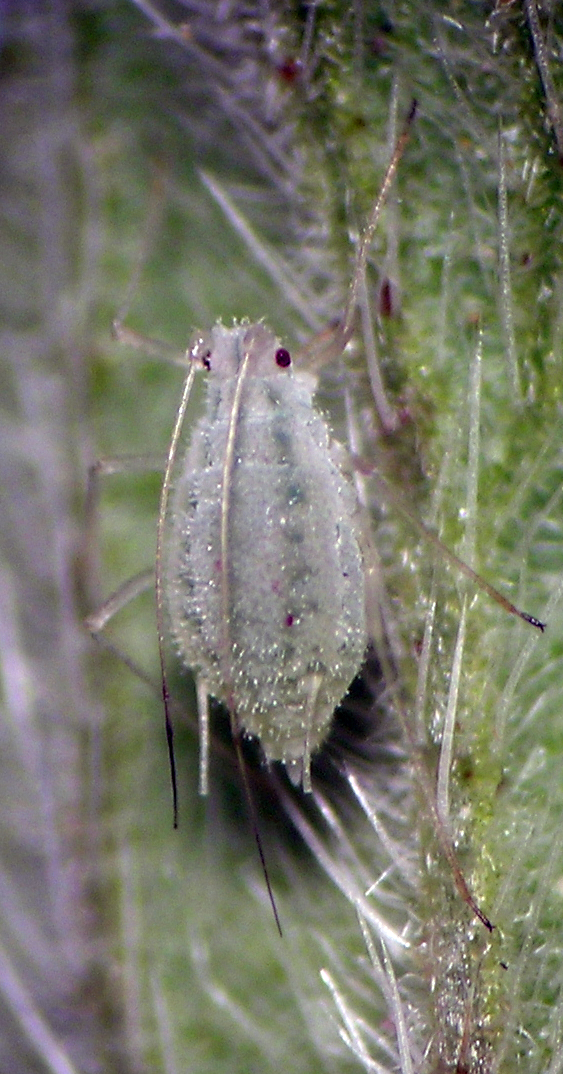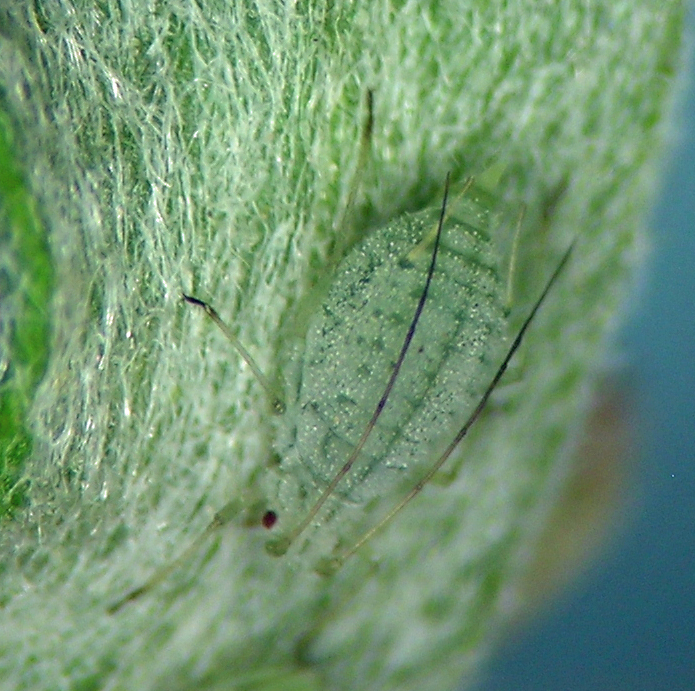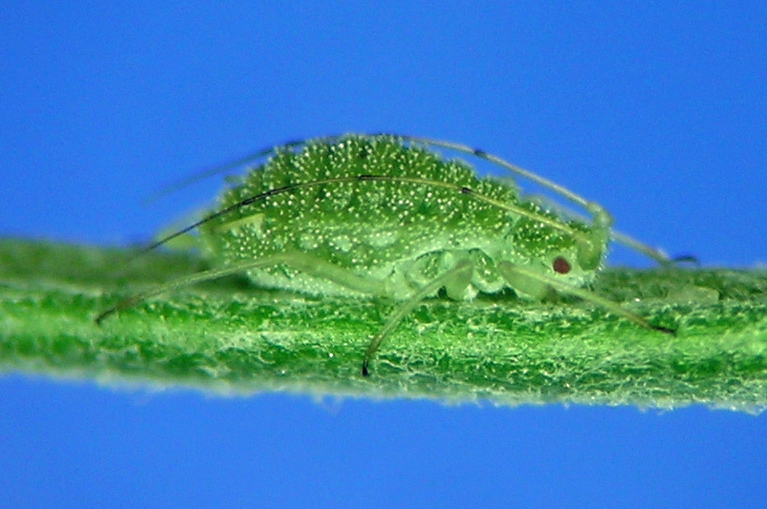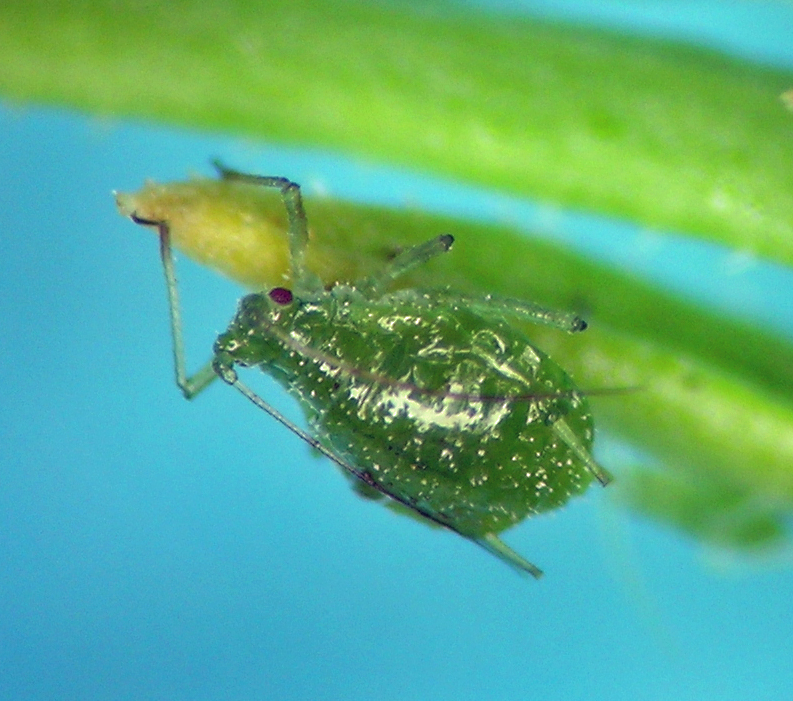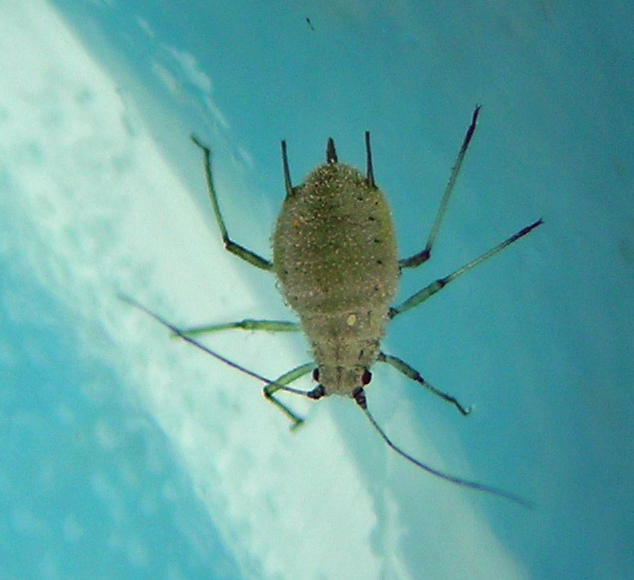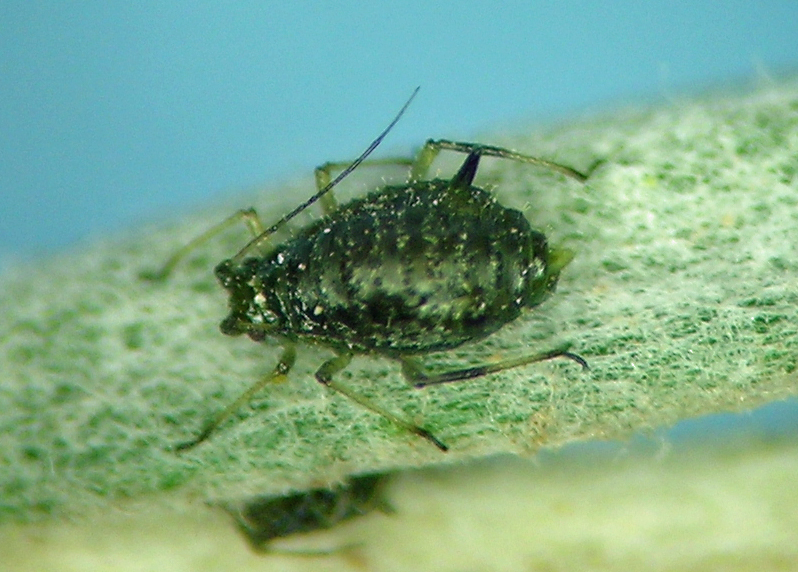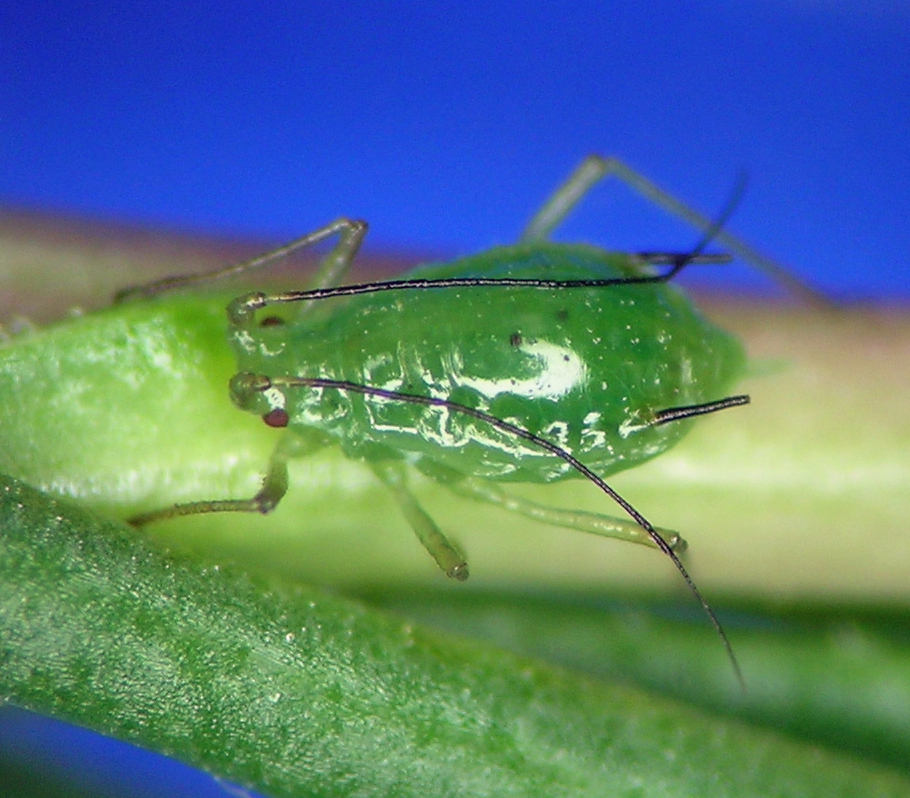Pleotrichophorus Börner
This page updated: December 2024.
This genus is one of my favorites. Many of its species are charismatic in some way, being excellently camouflaged, or being gaudy in color, or being especially fleet-of-foot. They are also terribly frustrating to photograph largely because of the latter trait. It seems like they, as with most aphids living on desert shrubs, are disturbed as soon as their host plant is jostled and especially once their leaf or sprig is clipped off. Once disturbed they stubbornly refuse to hold still for photos. There are many described species of Pleotrichophorus, and it seems to me that most of the accepted species are valid and recognizable in the field and on slides. The genus lives mostly on Asteraceae, and mostly on shrubs and perennial herbs in xeric habitats such as sagebrush (Artemisia) and rabbitbrush (Chrysothamnus).
The revision of North American Pleotrichophorus by Corpuz-Raros and Cook (1974) is really excellent in my opinion, especially considering neither author had done very much collecting in the field. After all my years of collecting this genus, I still find most samples fit fairly well one of the species concepts laid out in their paper. If I had infinite time and money to publish on aphids, I would love to do a complete revisit of their paper, pointing out all the ways they were right, and the few ways I think their work could be improved.
One issue with the genus is that some pairs or groups of similar species are recognized from the same host in different geographic areas. Also, sometimes two species are recognized for very similar aphids that vary in one major character such as length of siphunculi or a particular ratio of body part lengths. Based on my extensive collecting, I think close examination will reveal some of these species names to be applied to regional or host-plant variants of more widely distributed and variable species. An example of this issue are the species found on Achillea across North America (see P. patonkus below).
During fall of 2020 I made an effort to sort my material of several Pleotrichophous species including P. brevinectarius, P. gnaphalodes, P. decampus, P. zoomontanus, and P. quadritrichus. Sorting was made easier by having accumulated much material from all over the western U.S. What I found was that my identifications were mixed, and some of these ‘species’ were mixtures of 2, 3, or even 4 species that are actually fairly easy to recognize with adequate experience and comparative material (which I now have). These changes in identification were reflected in my 2021 release of the slide collection database.
In addition to the possibly erroneous splitting of geographically isolated populations of this genus into separate species, I consider another issue equally concerning: that some relatively distinctive ‘species’ that feed on several different plant species may be groups of similar-looking host-specific species. Examples of this phenomenon are what I had been calling P. brevinectarius and P. quadritrichus. There seem to be small but consistent differences in these ‘species’ based on Artemisia species they developed upon.
For several years I have been gathering samples of Pleotrichophorus from a native weedy plant called Iva axillaris (poverty weed). I have found this aphid in several western states. Since moving to Colorado I have it more or less in the front yard. When first found I ran it through the Corpuz-Raros and Cook key and it came out at P. parilis. At the time I lacked samples of this species from its previously known host, Artemisia dracunculus. Having found P. parilis on the latter plant in recent years, I decided in January 2024 to examine whether the form from I. axillaris can be consistently separated from P. parilis. The answer was, to my surprise, an easy “yes.” So, at some point I have at least one new species of Pleotrichophorus to describe!
Species covered below (click on the name to jump to that species):
- Pleotrichophorus amsinckii Richards
- Pleotrichophorus decampus (Knowlton & Smith)
- Pleotrichophorus oestlundi (Knowlton)
- Pleotrichophorus patonkus (Hottes & Frison)
- Pleotrichophorus pycnorhysus (Knowlton & Smith)
- Pleotrichophorus quadritrichus (Knowlton & Smith)
- Pleotrichophorus tetradymiae Smith & Knowlton
- Pleotrichophorus utensis (Pack & Knowlton)
- Pleotrichophorus zoomontanus (Knowlton & Smith)
Pleotrichophorus amsinckii Richards
This is an example of a species where my collecting and taxonomy has cast some uncertainty on an aphid’s biology. This species was originally described from Amsinckia intermedia in British Columbia, but since then I have collected it on Phacelia and Eriophyllum. As always with cases like this, it is possible that I misidentified the samples, but the unique morphology of this species is hard to miss. Still, the possibility of undescribed species with unusual morphology similar to P. amsinckii cannot be ignored. I also have a very similar, possibly undescribed, species from Arizona that was living on a Cirsium in the mountains. My samples of P. amsinckii are all from Oregon and Washington.
Pleotrichophorus decampus (Knowlton & Smith)
This is one of the common species of Pleotrichophorus most places I go in western North America. It lives on shrubby Artemisia. If I had learnt my sagebrush taxonomy a long time ago, I could tell you more about what species of sagebrush. Fortunately I have learned enough to tell you something: this aphid seems to have a broad host range of shrubby Artemisia including A. arbuscula, A. californica, A. cana, and A. tridentata (including at least two of its subspecies). I have a few samples that I recorded as being from herbaceous Artemisia, and they conform well with the morphology of samples from shrubby hosts. I’m not sure what to think about that. I have samples from Washington, Oregon, California, Idaho, Nevada, Utah, Colorado, Wyoming, and New Mexico.
Pleotrichophorus oestlundi (Knowlton)
One of the most common species of Pleotrichophorus, this one is also easily identified. Living on rabbitbrushes (Chrysothamnus and Ericameria), it is unusual for this genus in having extra setae on the top of the cauda. I have collected it in Washington, Oregon, California, Idaho, Nevada, Utah, Colorado, Wyoming, New Mexico, and Arizona.
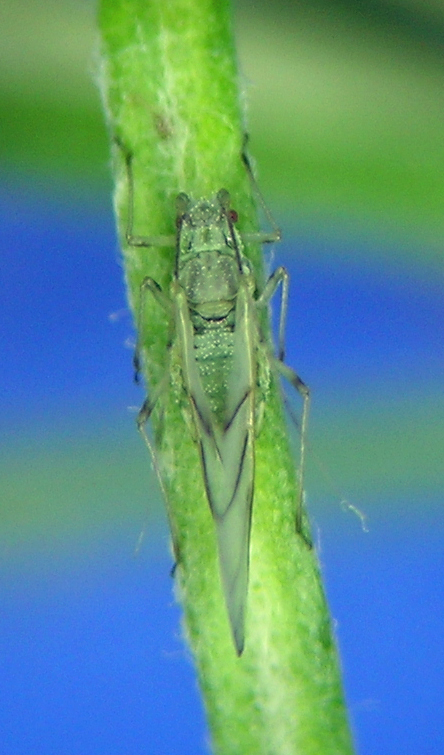
Pleotrichophorus patonkus (Hottes & Frison)
Almost everywhere I see Achillea in the wild, aphids I identify as P. patonkus are present. There are two other very similar described species from Achillea in North America (P. patonkusellus and P. pseudopatonkus), and they are not obviously distinct from P. patonkus. I made a new attempt at sorting my material of this group during fall of 2020. I recognize that there is a good range in length of siphunculi, shape and length R IV+V, and density of dorsal setae. However, the variations I see do not match up well with the features as reported in the primary literature. The most extreme character states are my samples from Maine and Quebec, which have rather short R IV+V and siphunculi, and sparse dorsal setae. All my other samples are similar to each other in terms of denser dorsal setae, but vary a bit in terms of R IV+V. Their dorsal setae, however, are not as dense as in the description of P. patonkusellus and in fact most bob around very close to the typical number for P. patonkus mentioned by Corpuz-Raros and Cook (1974). I tend to be a lumper in this case due to the apparent variation in characters thought to distinguish between the three “species.”
I have samples of this group from Washington, Oregon, Idaho, Utah, Colorado, New Mexico, and Quebec, but I have walked by many other possible collections due to the ubiquity of these aphids. As always, failing to collect samples is probably a mistake since it skews our understanding of common species. For example, the common house fly is hardly ever collected due only to its ubiquity.
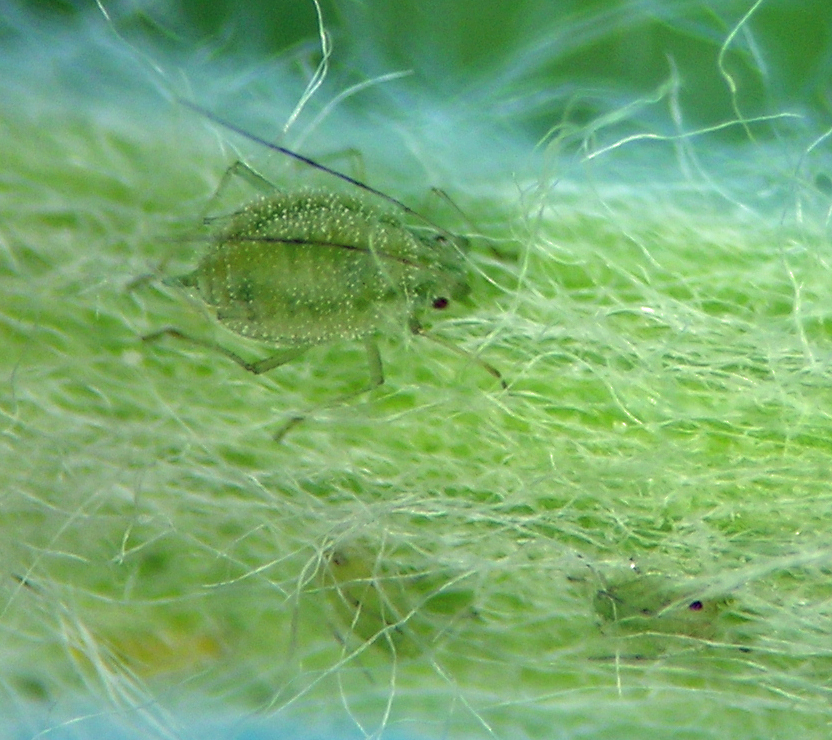
Pleotrichophorus pycnorhysus (Knowlton & Smith)
This species is relatively easy to recognize due its sparse dorsal setae (sparse for Pleotrichophorus, that is). Most of my samples are from what is known as green rabbitbrush, Chrysothamnus viscidiflorus, and the samples from other rabbitbrushes may well have been in error, vagrants, etc. This is an example of a Pleotrichophorus species that seems to be quite variable in terms of length of siphunculi. I so far have samples from Washington, Oregon, Idaho, Utah, and Nevada .

Pleotrichophorus quadritrichus (Knowlton & Smith)
This active species is common and widespread in western North America, and is relatively easy to recognize in part by its dark siphunculi and cauda. It lives on shrubby Artemisia (sagebrush). During fall of 2020 I looked through all my material of this species and sorted them according to host plant species: A. arbuscula, A. cana, A. rigida, and A. tridentata (at least two subspecies). There are subtle but consistent morphological differences based on host plant, such as length of antennal setae, density of dorsal setae, shape of the R IV+V, and leg pigmentation. Since moving to Colorado in 2021 I have also found this ‘species’ on Artemisia nova and Artemisia bigelovii. Perhaps another self-funded graduate student would want to drive all over the west making collections on known species and subspecies of Artemisia to sort all this out!?
I have samples from Washington, Oregon, Idaho, Nevada, Utah, Wyoming, Colorado, North Dakota, and New Mexico.
Pleotrichophorus tetradymiae Smith & Knowlton
Here is an aphid I sought for so many years that I lost track. From the description, it seemed like it would be an oddball, and sure enough it is, living on its uncommon host, Tetradymia canescens in the sagebrush steppe. Blackman and Eastop’s notes on it seem to imply that they did not believe the color-in-life notes from the literature, but here it is, in its “blackish green” color. I have only seen this aphid a couple times, in Oregon and Idaho.
Pleotrichophorus utensis (Pack & Knowlton)
Rare finds like this species are one of the things that keep me interested in pounding on rabbitbrushes everywhere I go. I have seen this species only a few times now in over 25 years of collecting aphids on rabbitbrushes, its hosts. In 2024 I found some oddball specimens that are similar to, but different from, this species, indicating things may be more complicated than previously known. I have samples from Washington, Oregon, Idaho, and Utah.
Pleotrichophorus zoomontanus (Knowlton & Smith)
I don’t have a photo of this large and fast-running species, but I wanted to briefly touch on it anyway. I’ve collected this species quite a lot over the past decade or so, and after a 2020 careful sorting of my samples of long-siphunculi Pleotrichophorus from Artemisia I showed that P. zoomontanus lives exclusively, or nearly so, on Artemisia cana, not A. tridentata as previously thought. A couple of my samples are marked as from A. tridentata, but these were from a time before my ability to identify species of Artemisia had developed. I have samples from Washington, Oregon, California, Nevada, Utah, Wyoming, and Colorado.


